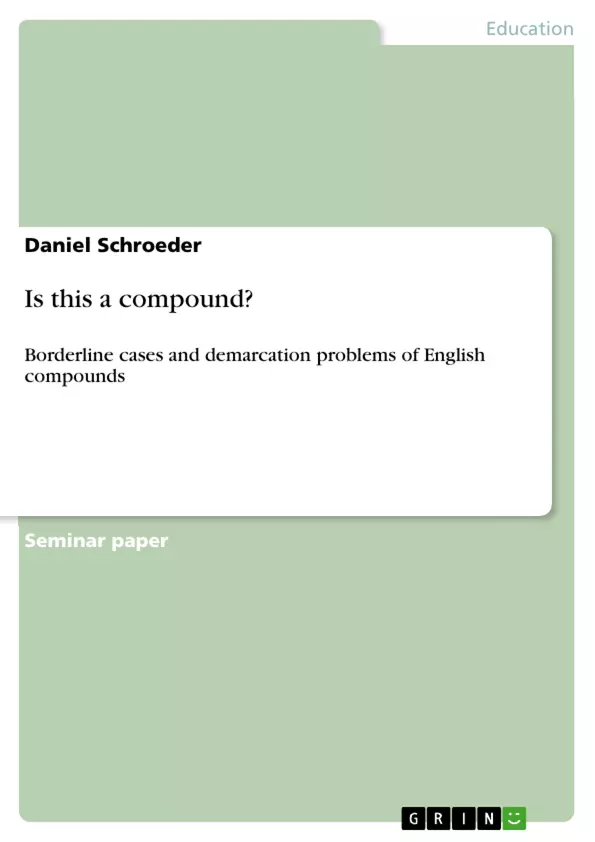People recognize, differentiate, and understand, therefore, categorize ideas and objects in everyday life. Unsurprisingly, linguists classify words. Compounds, for instance, are a part of the human language, and an interesting process of word-formation. ‘Is this a compound?’ Sometimes linguists are unsure whether certain words are compounds or not.
The definition of compounds is important because defining compounds simply “as being lexeme[s] whose immediate constituents are representatives of lexemes” (Bauer 2005: 105) creates a wide array of borderline cases. Since neo-classical compounds and phrasal compounds, for example, do not consist of two words, it is incorrect to categorize these classes as forms of compounding, according to the definition. This problem can be solved, if one defines a compound as “a word that consists of two elements, the first of which is either a root, a word or a phrase, the second of which is either a root or a word” (Plag 2003: 135). This definition explains the compound status of the neo-classical compounds because the constituents in these items, such as bio-, are central meaningful elements (bio- has the meaning ‘life’), thus, can be considered as bound roots instead of affixes (see, e.g., Plag 2003: 73). Additionally, Plag’s definition demonstrates that phrasal compounds can be classified as compounds because a phrase and either a root or word are joined together to a word in these complex words.
Despite the advantages that this definition reveals, demarcation problems cannot be solved and borderline cases still arise regarding English compounds. “[W]e must emphasize that these [continuing, D.S.] classification difficulties are […] the inevitable result of the fact that phenomena in living languages can rarely be compartmentalized into clearly […] distinguishable categories” (Schmid 2011: 131).
Firstly, this seminar paper will focus on the distinction between compounds and syntagmas and phraseologisms; secondly, the differentiation of compounds compared to other word-formation models that seem to have similar formations (dealing with the classes synthetic and verbal compounds) will be addressed. It will be discussed whether there are criterions that help to provide a sharp boundary between the mentioned processes. Additionally, this seminar paper aims to find solutions for ongoing borderline cases.
Inhaltsverzeichnis (Table of Contents)
- Introduction
- Compounds vs. syntagmas and phraseologisms
- Compounds vs. other word-formation patterns: problematic classes
- Synthetic compounds
- Verbal compounds
- Practical analysis: compounds with categorization problems in a newspaper article
- Conclusion
Zielsetzung und Themenschwerpunkte (Objectives and Key Themes)
This seminar paper investigates the complexities of identifying and classifying English compounds, focusing particularly on borderline cases. The paper explores the differentiation between compounds and other word-formation patterns, such as syntagmas and phraseologisms, and delves into specific challenges posed by synthetic and verbal compounds.
- Defining and identifying English compounds.
- Distinguishing compounds from syntagmas and phraseologisms.
- Examining problematic classes of compounds, such as synthetic and verbal compounds.
- Analyzing real-world examples of compound classification in a newspaper article.
- Identifying criteria for differentiating compounds from similar formations.
Zusammenfassung der Kapitel (Chapter Summaries)
- The introduction establishes the importance of defining compounds in English and highlights the difficulties in distinguishing them from other linguistic formations. It introduces the concept of borderline cases and previews the paper's objectives, which include analyzing the differentiation between compounds, syntagmas, and phraseologisms, as well as examining problematic classes of compounds.
- The second chapter delves into the distinction between compounds and syntagmas and phraseologisms. It defines each term and highlights the challenges in differentiating these structures. The chapter further explores the criteria used to distinguish compounds, including orthography, stress, meaning, and syntactic structure. Examples are provided to illustrate the complexities of this classification.
Schlüsselwörter (Keywords)
English compounds, word-formation, borderline cases, syntagmas, phraseologisms, synthetic compounds, verbal compounds, orthography, stress, meaning, syntactic structure.
- Citar trabajo
- MA Daniel Schroeder (Autor), 2013, Is this a compound?, Múnich, GRIN Verlag, https://www.grin.com/document/279072



